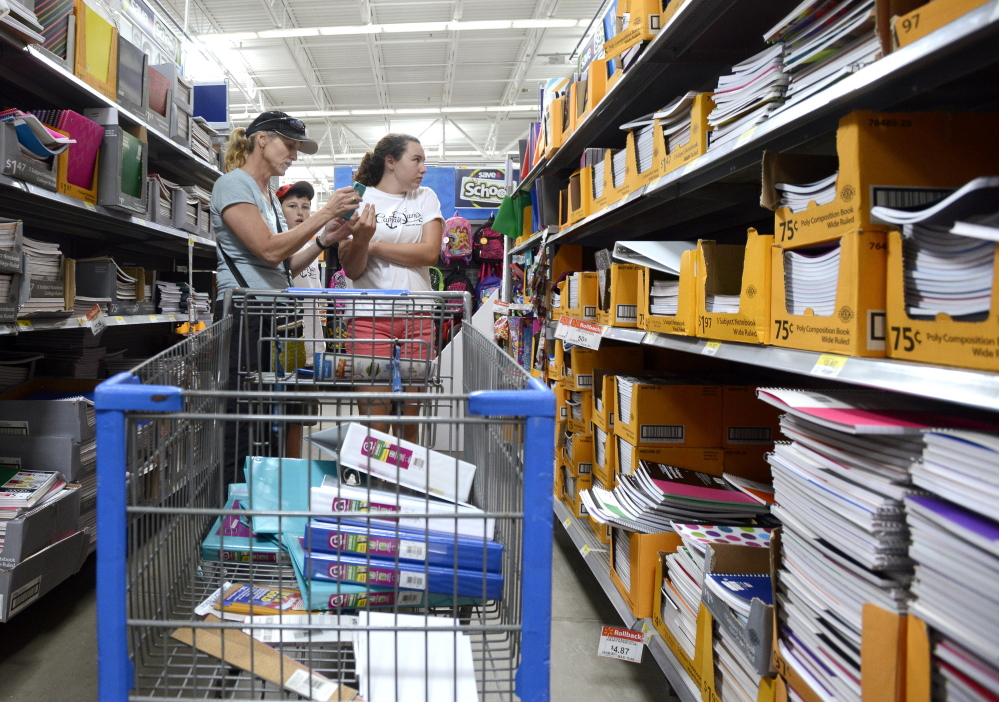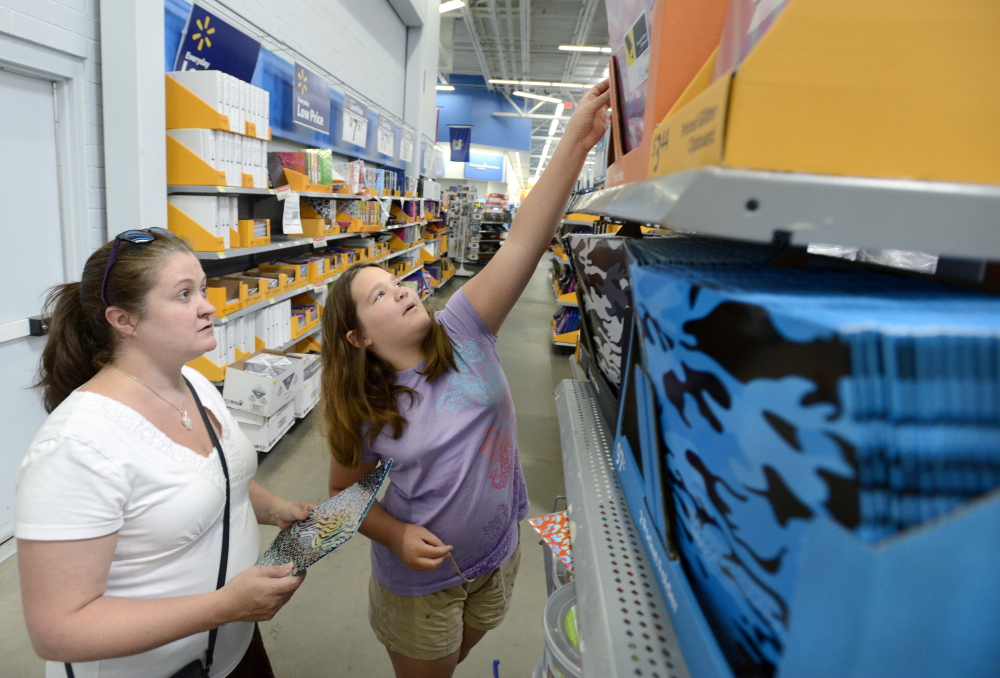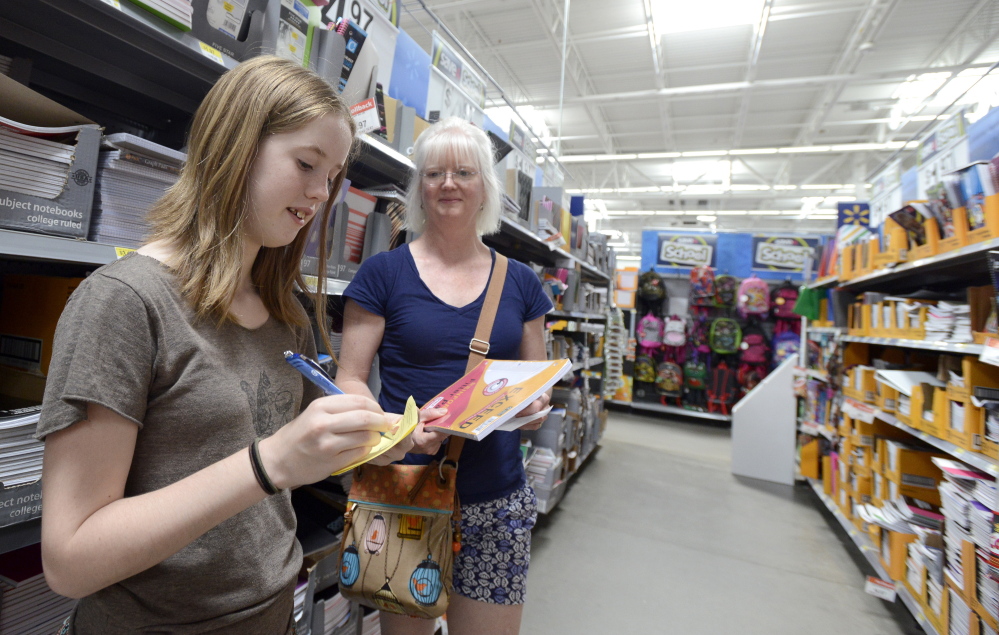SCARBOROUGH — Karen Morgan pushed her cart through the school supply section of Walmart last week, scrolling through a shopping list on her cellphone as her two youngest children picked out three-ring binders, protractors and pens.
Morgan has children in seventh, eighth and 10th grade at Greely Middle and High schools, and she expects her total shopping bill to be extra large this year as she invests in a laptop for her oldest son. She plans to spend $2,000 on the computer, plus hundreds more on school supplies, clothing, sneakers and sports equipment.
“Each year it seems to get a little bigger,” Morgan, a comedian and mother of three from Cumberland, said about the size of her list and the cost of buying school supplies. “I always end up coming back again after the first day.”
Nationally, families are spending more than ever to outfit students with new clothing, shoes and school supplies, an estimated 5 percent more than last year. Industry analysts say increases in back-to-school spending are a sign of a recovering economy, but they also highlight increased requests from cash-strapped school districts for donations of supplies and parents’ desire to provide new technology for their children.
“Over the past eight years, we’ve seen more and more supplies and more paper products for classrooms being requested,” said Maureen Brown, a spokeswoman for Huntington National Bank, which tracks back-to-school spending in its annual “backpack index.”
“What we also hear is that parents feel they should buy a tablet for the home because their children are using them in the schools,” Brown said.
Parents in southern Maine said they are spending more this year because their children require more clothing and supplies as they get older. Many elementary schools ask students to bring in basic supplies such as crayons and rulers, but by middle and high school, they may also need a notebook or binder for each class and technology such as $150 graphing calculators.
Throughout the school year, they also may encounter additional costs such as activity fees or insurance for school-provided laptops and tablets.
Nationally, the average family with children in kindergarten through grade 12 will spend $669 on apparel, shoes, supplies and electronics, up 5 percent from $635 last year, according to the National Retail Federation’s annual back-to-school survey. The group does not track costs by region or state.
Families with children in elementary school spend an average of $581, and that number jumps for families with children in middle and high school. The survey found the average family with middle and high school students will spend $682.
The amount families will spend on classroom supplies is expected to increase 12 percent to an average of $101, perhaps because school districts are increasingly asking for donations, according to the survey. But the bulk of back-to-school spending will be on clothes and shoes with the average family spending $355, according to the National Retail Federation.
“Slow improvements in the economy may have contributed to the growth in confidence among back-to-school shoppers, and while we are encouraged by the overall tone of the results and expect to see continued improvement in consumer spending through the year, we know Americans are still grappling with their purchase decisions every day,” said Matthew Shay, president and CEO of the National Retail Federation.
Jeremy Ray, superintendent of Biddeford schools, said teachers try to keep requests for classroom supplies to a minimum to avoid burdening parents who might not be able to afford extras.
“Anything parents send in certainly helps, but in the long run the students will be provided with the materials they need,” he said. “Going back to school should not be a stressful and costly thing for parents.”
Margaret Pitts, principal of Biddeford Primary School, said the school sends home lists with about seven suggested items, all around $1. Teachers try to keep their requests simple, she said.
“We recognize the economic times some people are in. We want to help control the costs,” she said.
Bil Moriarty, a school committee member in Biddeford with two daughters in school, said the lists can be daunting, but providing even a few boxes of crayons to a classroom helps when school budgets are tight.
“As a parent, it can be frustrating when you get that list, but I believe if you can afford to donate supplies, go ahead,” he said.
Nicole Foster, a mother of four from Windham, isn’t fazed by the lists requesting supplies that will be used by the entire class. As a school volunteer, she’s aware there are shortages of supplies.
“You’d think that sharpened pencils with erasers are readily available, but they’re not,” she said. “People always assume that someone else will send it in or already has.”
Americans also are spending more this year on electronics, clothes and shoes, according to the back-to-school survey. Parents are expected to spend an average of $231 on clothes, up slightly from last year. They will spend an average $124 on shoes, about $10 more than in 2013.
Back-to-school shoppers will spend an average of $212 on electronics, an increase of 7 percent from last year. High school students and their families will spend the most, averaging $230.
Most middle and high school students in Maine have access to tablets or laptops through school, but parents still might find themselves paying associated costs. Foster, the mother from Windham, said her two oldest children will have a school-issued tablet or computer, but she will have to pay $25 for insurance on each. She also has to buy an iPad case for her daughter, who is in seventh grade.
Regina Lemire and her 10-year-old daughter, Saige, a fifth-grader at Westbrook Middle School, shopped for supplies at Walmart last week. Saige already had picked out notebooks and pens and added extras such as brightly colored erasers. Lemire also has a daughter in high school and expected to spend around $40 on school supplies — and a total of $400 to $500 once they finish shopping for clothes and shoes.
“As they get older, there’s more we need,” she said, adding that they were lucky to avoid costly electronics purchases this year.
Amy Gleason, the mother of three daughters in elementary school in Buxton, said she’s noticed clothing and shoe prices have been creeping up, so she expects to spend close to $350 per child on clothing and supplies.
“The biggest expense is clothing,” she said. “When school ends, I start saving up for clothes.”
Copy the Story LinkSend questions/comments to the editors.






Success. Please wait for the page to reload. If the page does not reload within 5 seconds, please refresh the page.
Enter your email and password to access comments.
Hi, to comment on stories you must . This profile is in addition to your subscription and website login.
Already have a commenting profile? .
Invalid username/password.
Please check your email to confirm and complete your registration.
Only subscribers are eligible to post comments. Please subscribe or login first for digital access. Here’s why.
Use the form below to reset your password. When you've submitted your account email, we will send an email with a reset code.